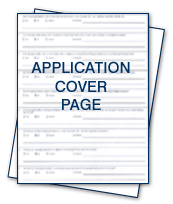
The Application Cover Page includes data needed about your community. It should be the first page of your application. The following notes explain Sections 1 through 8 on the cover page. All of these items must be included with your application package.
Click here to access a copy of the Application Cover Page.
- Your NFIP number and "FIRM Effective Date" are found on the legend of your FIRM. The latter is usually the date of conversion to the Regular Program of the NFIP. The "Current FIRM Date" is the date on the FIRM Index Map (or the FIRM legend if only one panel was printed).
- Your Chief Executive Officer (CEO) is your mayor, county board chair, city manager, or other person of equivalent position. Your CEO must designate your community's CRS Coordinator.
- Your application must include the letter from the FEMA Regional Office stating that your community is in full compliance with the NFIP. The letter must be dated no more than 6 months before your application date.
- Check each activity for which you are applying. One space is already checked because Activity 310 (Elevation Certificates) is a minimum requirement for participation in the CRS. You must complete and submit the worksheet page for Activity 310 (Elevation Certificates).
You must check to see if you are a repetitive loss community. Read and complete the section on Repetitive Loss Requirements. If you have one or more repetitive loss properties, you must obtain the list of properties from FEMA and complete the 2 worksheet pages for repetitive losses. Category C communities (those with more than 10 repetitive loss properties) must also apply for Activity 510 (Floodplain Management Planning).
Your CEO's signature certifies that your community is actually implementing the activities in your application. This certification does not mean that you will start doing them; it means that your community is doing them as of the date of your application.
- Your application must include completed copies of the appropriate worksheet pages and the documentation that is required for each activity. The worksheet page Community Total Points is also required to show your total points. You may apply for any of the other activities, as long as all of your activities add up to 500 points or more.
- The National Flood Insurance Act, as amended in 1973, requires "the purchase of flood insurance by property owners who are being assisted by Federal programs or by Federally supervised, regulated or insured agencies or institutions in the acquisition or improvement of land or facilities located or to be located in identified areas having special flood hazards."
As a property owner, a local government is subject to this law as well. If your community received Federal financial assistance for a community-owned building in the floodplain, you are required to maintain flood insurance on that building. Examples of Federal financial assistance you may have received include Environmental Protection Agency grants to improve wastewater treatment plants, Community Development Block Grants, and FEMA disaster assistance for damaged buildings.
Your CEO must certify that you have all the flood insurance policies that you have been required to have. The CRS is not concerned with past lapses in flood insurance coverage. What counts is that NFIP insurance is in effect when you apply and is kept in the future. The CRS Coordinator should make every effort to determine the community's legal requirement to purchase flood insurance.
- The cover page must be signed by your community's CEO. This form cannot be signed by a department head or other staff person.
|

